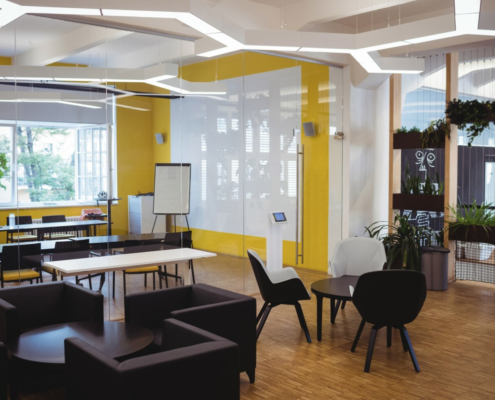How AI Agents are Reshaping Connectivity
The buzz around Artificial Intelligence (AI) is undeniable. The recent significant funding round by OpenAI, even amidst global economic shifts, underscores the transformative power AI holds for businesses across all sectors. For the telecommunications industry, this isn’t just a technological advancement to consider – it’s the fundamental shift that will define future success.
At ISL Office Solutions, we understand the critical role robust and reliable telecommunications infrastructure plays in enabling seamless collaboration and productivity for businesses. As the digital landscape evolves, so too must the networks that underpin it. This is where the emergence of sophisticated AI agents becomes not just interesting, but essential.
The article, “How AI agents will reshape telecoms,” by Computer Weekly (https://www.computerweekly.com/opinion/How-AI-agents-will-reshape-telecoms), astutely points out that for telecoms operators, embracing autonomous AI agents is no longer optional – it’s the very key to survival in an increasingly competitive and technologically advanced world. This resonates deeply with our vision at ISL Office Solutions, where we strive to provide cutting-edge connectivity solutions that empower our clients.
The Rise of Intelligent Agents: Autonomous Power for Telecoms
The core of this transformation lies in the rise of AI agents – intelligent software entities capable of pursuing long-term objectives independently. These agents can interact with complex environments, processing vast amounts of data from various sources like text, images, video, and audio. Their ability to break down intricate problems, prioritise tasks, and learn continuously through feedback loops positions them as powerful tools for optimising and managing complex telecom networks.
While still in the early stages of widespread adoption, the article highlights how leading telecom operators are already exploring the potential of AI agents in crucial areas:
- Network Optimisation: AI agents can analyse network traffic and performance data in real-time, identifying bottlenecks and dynamically allocating resources to ensure consistent optimal performance. This proactive approach minimises disruptions and maximises network efficiency – a cornerstone of the reliable services ISL Office Solutions provides.
- Predictive Maintenance: By continuously monitoring network infrastructure, AI agents can predict potential failures before they occur. This allows for proactive maintenance scheduling, minimising downtime and reducing operational costs – benefits that directly translate to more stable and cost-effective solutions for our clients.
- Resource Allocation: AI agents can intelligently manage and distribute resources like bandwidth to adapt to fluctuating demands, ensuring consistent service quality even during peak usage times. This dynamic resource management is crucial for delivering the seamless connectivity our clients rely on.
The discussions at Mobile World Congress 2025 further underscore the growing importance of agentic AI in telecoms. The collaborations between industry giants like Deutsche Telekom and Google Cloud, and Ericsson and Telenor, demonstrate a clear commitment to leveraging AI for autonomous networks and optimising resource consumption – a focus that aligns with ISL Office Solutions’ dedication to providing efficient and sustainable solutions.

A New Era for Telecoms and ISL Office Solutions
The integration of AI agents signifies a new era for the telecommunications industry. As networks become increasingly intricate, traditional rule-based automation will struggle to keep pace with real-time demands. AI agents offer the intelligence and adaptability needed to navigate these complexities, reduce latency, and enhance service delivery – all critical factors in the solutions ISL Office Solutions provides to our clients.
For ISL Office Solutions, this evolution presents exciting opportunities to enhance our service offerings. By leveraging AI-powered tools, we can:
- Proactively monitor and manage our clients’ network infrastructure, ensuring optimal performance and minimising disruptions.
- Offer more intelligent and responsive support services, leveraging AI agents to diagnose and resolve issues more efficiently.
- Develop more personalised and tailored connectivity solutions based on data-driven insights into our clients’ specific needs.
Navigating the Challenges Ahead
The article rightly points out that the journey towards AI-driven telecoms is not without its challenges. Data privacy and security are paramount concerns as AI agents process vast amounts of sensitive data. At ISL Office Solutions, we recognise the importance of robust security measures and are committed to ensuring the confidentiality and integrity of our clients’ data as we explore and implement AI-powered solutions.
Integrating AI agents with existing legacy systems also presents a technical hurdle. Ensuring seamless compatibility without disrupting service continuity requires careful planning and execution – a challenge ISL Office Solutions is prepared to address with our experienced technical team. Furthermore, the shift towards AI-driven decision-making necessitates upskilling and training for our staff to effectively collaborate with these intelligent systems. We are committed to investing in our team’s development to ensure they are equipped for this evolving landscape.
Looking to the Future: Intelligent Connectivity with ISL
Looking ahead, AI agents are poised to become central to telecommunications operations, driving cost reductions, enhancing efficiencies, and unlocking new service offerings. For ISL Office Solutions, our “north star” is not only to understand and deploy these technologies effectively but also to cultivate an ecosystem that supports continuous innovation. This will enable us to stay ahead of the curve and deliver faster, more reliable, and increasingly personalised services to our valued clients.
The future of telecoms is intelligent, and at ISL Office Solutions, we are committed to embracing this future to provide you with the most advanced and reliable connectivity solutions available. Stay tuned as we explore the potential of AI to further enhance your communication and collaboration capabilities.







